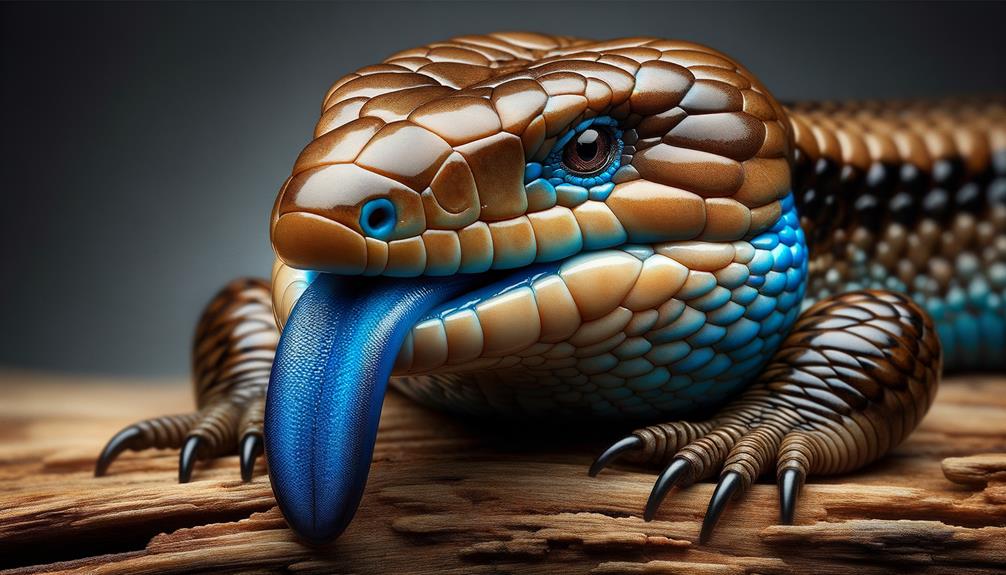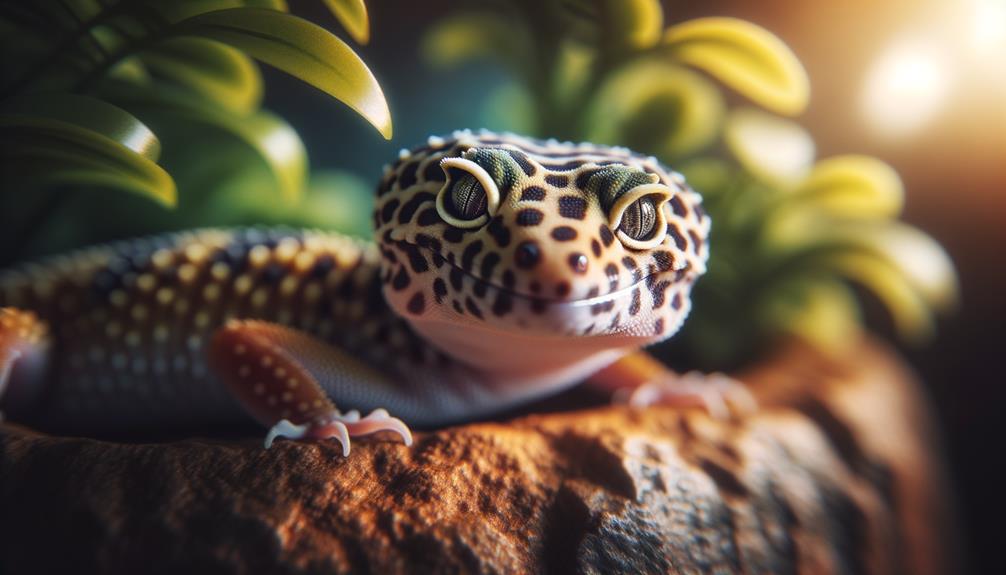I've always been fascinated by blue-tongued skinks, those gentle giants of the reptile world. Their striking blue tongue, used to deter predators, is a remarkable feature. These creatures can grow up to 20 inches in length, making them a substantial species. They thrive in diverse habitats, from the semi-deserts of Australia to the dense forests of New Guinea. Their diet is equally varied, consisting of insects, fruits, and vegetation. With consistent gentle handling, their docile nature makes them a great pet choice. To care for them properly, you'll need a spacious enclosure, a balanced diet, and proper temperature control. There's much to appreciate about these remarkable lizards, especially if you're interested in discovering their unique traits.
Key Takeaways
Blue-tongued skinks are known for their gentle and approachable nature, making them an excellent choice as pets. With consistent and gentle handling, they become more affectionate and less defensive over time. One of their most distinctive features is their bright blue tongue, which serves as an effective deterrent to predators. Due to their territorial behavior and potential for aggression, it's essential to house them individually. In terms of size, blue-tongued skinks are quite large, growing up to 20 inches in length, with a stocky build.
Habitat and Distribution
Blue-tongued skinks, native to Australia, Tasmania, and New Guinea, have adapted remarkably well to diverse habitats, from open woodlands and grasslands to semi-deserts. I've always been fascinated by their ability to thrive in such varied environments. In Australia, they can often be found basking in the sun amidst the sparse vegetation of semi-desert regions, blending seamlessly with their surroundings. New Guinea, with its rich and varied landscapes, offers them plenty of opportunities to explore dense forests and humid grasslands.
These skinks are masters of their habitats, preferring to stay low to the ground, seeking refuge under logs, rocks, and leaf litter. This not only protects them from predators but also helps regulate their body temperature in the warm, humid climates they love. They're particularly fond of burrowing and creating cozy shelters that offer a safe haven from the elements.
What's truly remarkable is their ability to thrive in such varied environments. Whether traversing the dry expanses of Australia or the lush terrains of New Guinea, blue-tongued skinks showcase incredible adaptability, making them true terrestrial marvels of their regions.
Physical Characteristics

As I marvel at the adaptability of blue-tongued skinks, I'm equally fascinated by their striking physical characteristics that make them truly unique. These medium-sized lizards, found throughout regions like New South Wales in Australia and New Guinea, have an array of fascinating features.
First and foremost, the bright blue tongue is their most iconic trait. It's not just for show; this vibrant hue serves as a formidable deterrent to predators. When threatened, a skink will display its blue tongue in a dramatic bluff to scare off potential threats.
Their stocky build and short legs give them a robust, grounded appearance, while their broad, flattened heads add to their distinctive look. These skinks can grow up to an impressive 20 inches in length, making them one of the larger lizard species.
The dazzling variety of colors on their skin, ranging from blues and blacks to browns and intricate combinations, is another captivating aspect. Their smooth scales and high-gloss finish make them appear almost polished.
Their physical characteristics not only make blue-tongued skinks visually striking but also equip them to thrive in their diverse habitats.
Key Features:
- Bright blue tongue: A predator deterrent.
- Stocky build: Robust and grounded.
- Variety of colors: Blues, blacks, browns, and combinations.
- Smooth scales: High-gloss appearance.
Diet and Nutrition

When it comes to their diet, blue-tongued skinks enjoy a diverse mix of insects, fruits, and vegetation, showcasing their adaptable nature. Whether you have a new pet skink or a seasoned companion, a varied diet is key to their well-being. As omnivores, skinks thrive on a mix of insects like crickets and mealworms, alongside vegetables and greens, ensuring they receive balanced nutrition.
In the wild, these gentle giants would feast on small rodents, fruits, and snails, using their strong jaws to crush hard-shelled prey. In captivity, their diet should be both nutritious and engaging. Supplementing their meals with calcium and vitamins is vital for their health and growth. Don't forget to provide a fresh bowl of water to keep them hydrated!
| Food Type | Examples | Frequency |
|---|---|---|
| Insects | Crickets, Mealworms | 2-4 times a week |
| Vegetables & Greens | Kale, Collard Greens | Daily |
| Fruits | Berries, Apples | Occasional |
Feeding adult skinks 2-4 times a week, offering as much as they'll consume in one sitting, keeps them happy and healthy. By creating a balanced diet, you can ensure your skink leads a happy and healthy life.
Behavior and Temperament

One of the most appealing aspects of owning a blue-tongued skink is their gentle and approachable nature, making them an ideal pet for both beginners and experienced reptile enthusiasts. These calm creatures, native to regions like Papua New Guinea, are part of a diverse group of skink species. While they may initially exhibit defensive behaviors such as hissing or puffing up, consistent and gentle handling can quickly tame them, transforming these animals into genuinely affectionate companions.
Blue-tongued skinks are territorial, so it is essential to house them individually to prevent aggression. When feeling threatened, they often curl into a C-shape, displaying their vibrant blue tongue as a warning. Despite their short legs and inability to leap or climb high, their strong jaws and teeth mean they can deliver a powerful bite if provoked.
Their calm demeanor and unique behaviors make blue-tongued skinks a fascinating choice among the different species of the skink family, ensuring they make great pets for anyone seeking a unique and manageable reptilian companion.
Key characteristics of blue-tongued skinks include:
- Their generally calm and easy-to-handle nature
- Their territorial behavior, which requires individual housing to prevent fights
- Their defense mechanism of curling into a C-shape and displaying their blue tongue
- Their powerful jaws and teeth, which can deliver a strong bite if threatened
Care and Maintenance

Caring for blue-tongued skinks can be a highly rewarding experience, but it requires attention to their specific habitat, diet, and health needs. To provide the best environment, a minimum 40-55 gallon enclosure is necessary for adults, with a temperature range of 70-95 degrees Fahrenheit. This allows them to regulate their body temperature effectively. Hiding spots and substrates like aspen shavings or cypress mulch, along with UVB lighting, are crucial for their well-being.
A well-balanced diet is essential. Blue-tongued skinks are omnivores, requiring a mix of 60% plant matter and 40% animal protein. A suitable diet might include leafy greens, fruits, raw meat, and occasional pinkie mice, fed 2-4 times a week. Monitoring their eating habits and adjusting as necessary is vital.
Handling these gentle creatures can be enjoyable, but it's essential to handle them gently and avoid sudden movements that might startle them. Maintaining proper humidity levels between 20-45%, providing fresh drinking water, and monitoring for health issues like mouth rot or parasites are also vital. With proper care, these skinks will thrive and bring joy to your life.
Frequently Asked Questions
Are Blue-Tongued Skinks Friendly?
Blue-tongued skinks are known for their friendly nature. They're incredibly docile and approachable, making them a great pet for reptile enthusiasts. With regular handling and socialization, they can recognize and interact with their owners, forming a strong bond.
What Are the Friendliest Skinks?
When it comes to friendly skinks, the Irian Jaya and Centralian blue-tongued skinks are incredibly gentle, making them a pleasure to handle. The Eastern blue-tongued skink is also known for its calm nature and friendly demeanor, especially when it receives regular interaction.
Are Blue-Tongued Skinks Affectionate?
Blue-tongued skinks can be quite affectionate in their own way. While they may not snuggle like a cat, they often approach me for feeding or playtime, showing clear comfort and recognition with consistent, gentle handling.
Are Blue Tongue Skinks Personable?
Did you know that a significant number of blue-tongued skinks can become tame with regular handling? These curious and friendly reptiles are a joy to interact with, making them a great pet choice.



